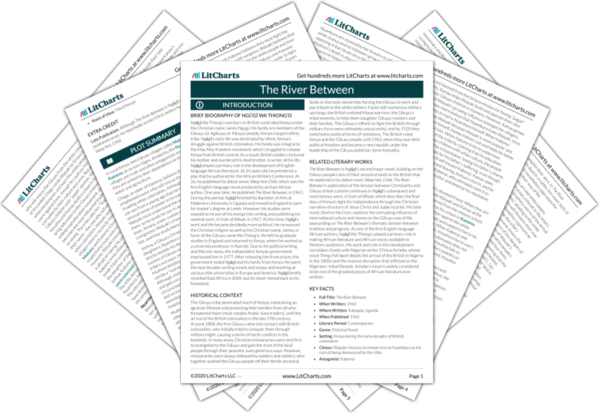Makuyu, one of the two Gikuyu villages where the novel is set, represents the white people’s Christianity as well as the way that they use religion as a means to quietly further their colonial efforts. Joshua and Kabonyi, both originally from Makuyu, are among the first villagers to convert to Christianity and submit themselves to the white missionaries’ authority, and Joshua even establishes a Christian church in the village. Although white people never enter the villages, Joshua’s church becomes the locus of white authority and influence in the ridges, particularly since Joshua is so loyal to the white missionary’s authority. While the Kiama and loyal tribespeople practice their traditional rites in Kameno, Joshua and his followers spurn those traditions in favor of Christian holidays like Christmas. Rather than practice tribal traditions like circumcision, the ultimate mark of Gikuyu tribal identity, Joshua and his people in Makuyu spurn such traditions as sinful “pagan” rites and substitute with Christian practices such as baptism, even though they have less history and thus less meaning for the Gikuyu people.
Given that Makuyu is a symbol of the white people’s Christianity, it’s particularly significant that the white colonialists build their first government outpost in the ridges behind Makuyu. This speaks to the way that the colonialists use Christianity as a front for their colonial efforts both to hide their true intentions and to gain the local people’s trust.
Makuyu Quotes in The River Between
The ridges were isolated. The people there led a life of their own, undisturbed by what happened outside or beyond. Men and women had nothing to fear. The [white people] would never come here. They would be lost in the hills and the ridges and the valleys.

Unlock explanations and citation info for this and every other The River Between quote.
Plus so much more...
Get LitCharts A+The ridges slept on. Kameno and Makuyu were no longer antagonistic They had merged into one area of beautiful land, which is what, perhaps, they were meant to be.
“Take Siriana Mission for example, the men of God came peacefully. They were given a place. No see what has happened. They have invited their brothers to come and take all the land. Our country is invaded. This Government Post behind Makuyu is a plague in our midst.”
The land was now silent. The two ridges lay side by side, hidden in the darkness. And Honia river went on flowing between them, down through the valley of life, its beat rising above the sark stillness, reaching into the heart of the people of Makuyu and Kameno.












